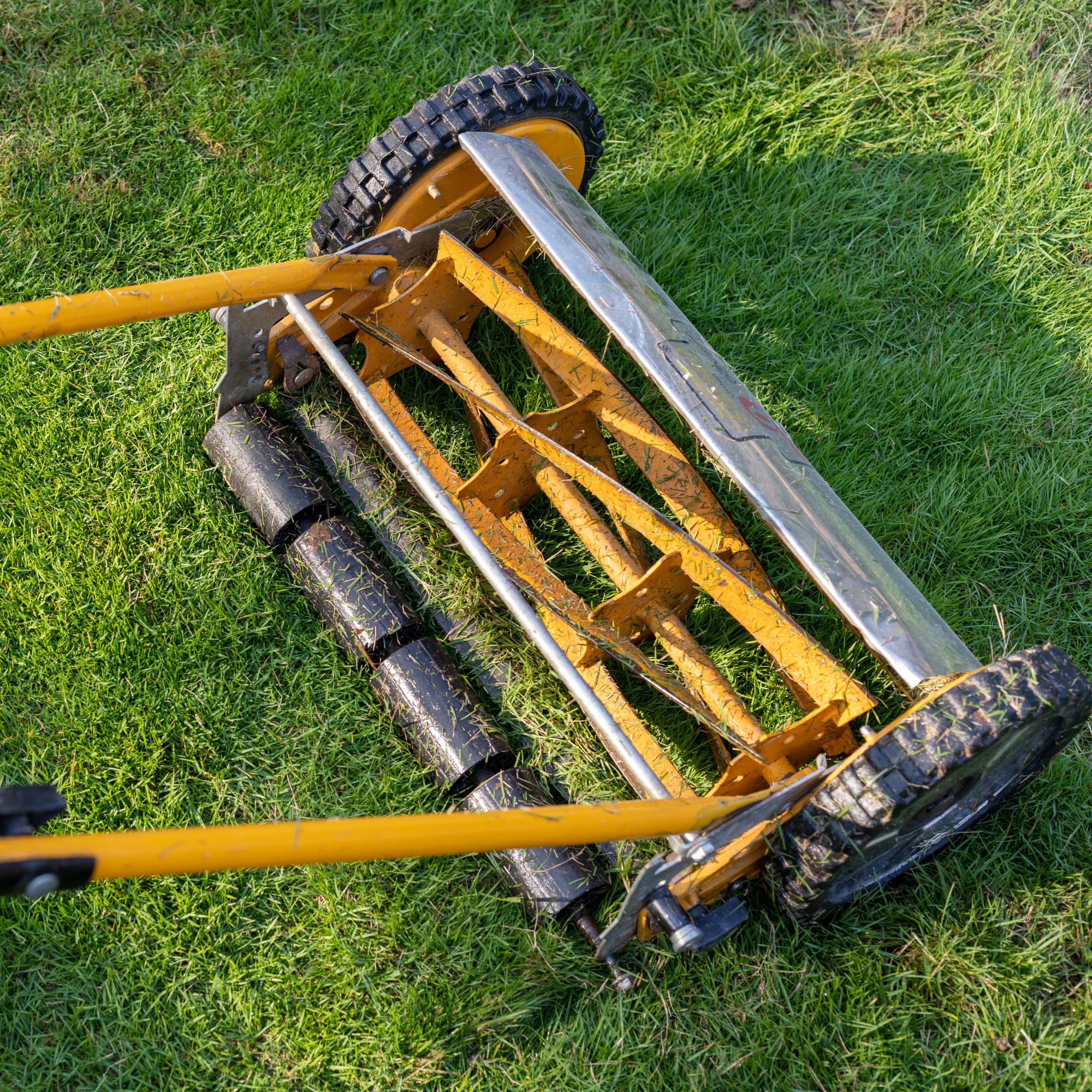A manual lawn mower is the low-cost alternative to modern mowers – I weighed the benefits and drawbacks
I tested a manual lawn mower to see if they're worth the switch

Sophie King

Is it worth getting a manual lawn mower? Cutting our grass can be a time-consuming task, so it's important to consider the pros and cons of this mower style before you buy one.
Before many of the best lawn mowers on the market entered the room with their electric, petrol and cordless bragging rights, there was the manual mower, or hand mower. Still, many gardeners dub manual mowers their favourite kind of model to this day.
But is it worth getting a manual lawn mower? To find out, I've weighed the benefits and drawbacks, and I even put the Bosch AHM 38G to the test to give manual mowers a whirl myself.
Pros of a manual lawn mower
They cost little to buy and run
As well as costing far less than an electric or petrol mower to buy, manual lawn mowers have no ongoing fuel costs.
The Bosch AHM 38G I tested, costs as little as £59.99 on Amazon at the moment, and while you can get a cheap electric mower for under £100, electricity will cost you a small amount (probably around 5p/hour) for every use.
Petrol mowers will need approximately two-thirds of a litre of fuel for every hour of mowing, meaning they cost more to run – around £1 an hour at current petrol prices.
Petrol mowers also need regular servicing, and although all mowers will need new blades or sharpening at some point, the lower additional costs still make a hand push mower the cheapest to run and buy.
Sign up to our newsletter for style inspiration, real homes, project and garden advice and shopping know-how
No wires, no problem
The corded vs cordless lawn mower debate is an ongoing one, and while I already have a cordless mower, there is even less faff getting a manual mower out and set up.
You only have to attach the grass box (unless dispersing clippings for mulch), and you're ready to go. No plugging it in, no checking batteries are charged, and you don’t even have to turn it on. If you have a long garden like mine, this freedom does take the faff out of a weekly mow.
Easy to use and maintain
This mower type is human-powered, and you are the 'on' button. So as long as you have the energy to push the mower up and down your lawn, and know how to mow a lawn, you are good to go.
They are fairly light and easy to use and store – you might find you can hang it neatly in your shed which is a bonus. And, maintenance is minimal. You just have to use a stiff brush to flick grass off after each mow and occasionally sharpen the blades.
It's quiet

It was hard work, but the push mower even handled my long grass
Another brilliant thing about manual lawn mowers is that they aren't noisy, because they don't have an engine.
'If the user wants something more eco-friendly, low-cost cost and quiet, a manual mower could be an option,' agrees Ryan Petterson, UK product manager at Husqvarna. 'These are some of the key benefits, whilst they also tend to be low maintenance and lightweight.'
The cut with a reel mower is really neat
Hand push mowers use a reel cutting system instead of a rotary blade. This is a barrel with blades around it and a blade on the body of the machine. As you push, the barrel and blades rotate, catching any grass in their path and cutting them much like a pair of shears. The result is a cleaner cut than a rotary blade, which severs the top of the grass, helicopter style.
The second your rotary blade loses sharpness, it tends to push and mangle the grass, rather than neatly cut. Not only does this look messier, but makes your grass more vulnerable to disease.
My push lawn mower has a roller too, so if you like a nice stripy finish, you will be impressed by the results – even on longer grass.
If you are going to mow, this is the most sustainable way to do it*

No fuel, generally made from metals that can be recycled, and easy to repair, push mowers offer a sustainable way to mow if you must. After all, we know we should leave our lawn a little longer for pollinators, so if you are a bit more laissez-faire with your lawn, an affordable manual mower for when need must is not a big investment.
(*Okay, so a scythe is arguably more sustainable from a material standpoint. But also terrifying and nowhere near as neat.)
Cons of a manual lawn mower
Can be hard work (especially on a big lawn)
Manual by name and nature, you will find yourself having to put a bit of weight behind your push mower. Unlike a powered rotary mower, this type of mower’s blade is powered and turned by you pushing it. On the nice even bits of my lawn, this was a breeze. However, once I reached some slightly bumpier bits, it was a bit more of a jerky operation. It certainly gives you a good workout, but isn’t recommended for those with mobility concerns.
Luckily, my lawn is fairly small, but I can see this being quite exhausting in a large space that isn’t frequently tended to. If you want to keep the job easy, mowing little and often is the secret to success with a hand push mower.
Can clog on long or thick grass

When I made the mistake of leaving the lawn a little bit long, I found the grass had a tendency to wrap itself around the barrel and wheel axels. I could fix this wearing thick gloves and using a stick to push the grass out of the way, but it did lead to a slightly stop-start operation.
Likewise, patches of thick grass really needed me to put my back into it. You have to give the mower a good push to get enough force to shift the barrel to clip anything brush like. My cordless mower also clogs, but has the power to handle an unruly lawn and can easily be adjusted to do a pre-mow to thin it out a bit first.
'Manual lawn mowers are less effective on tall, thick or uneven grass and tend to have narrower cutting widths, meaning larger lawns can take a lot longer,' says Ryan from Husqvarna.
You can't mow over sticks

Technically, you should clear your lawn of debris with any mower, as it will dull the blades and can launch sticks and stones at your face mid-mow. However, a powered mower can handle the odd stick or thin branch that falls from my cherry tree.
The manual mower was not so accommodating. I cleared the lawn first, but inevitably missed a large twig and won't make that mistake again. It got lodged in the blades, and it did feel slightly risky getting it out.
Conclusion: is it worth getting a manual lawn mower?
A manual lawn mower is definitely worth the relatively small expense if you are looking to keep your lawn neat on a budget. It is a very traditional method of grass cutting and does require some legwork, but if you get into the habit of regularly maintaining your lawn, the results are very pleasing.
They are convenient if you have a smaller lawn or trouble reaching power points, and better than noisy petrol if you live in a built-up area. In fact, they are very quiet and the clacking noise they make is probably a very niche form of ASMR.
I wouldn’t recommend them for anyone who will find it hard to push for mobility reasons, or those with a very uneven lawn. They demand a little muscle. So if this sounds like you, either go for an affordable cordless lawn mower… or embrace the wilder look insects love instead and don’t mow at all.
So, am I still using it? The short answer is no. The longer explanation is, I have a great cordless lawn mower that is perfect for a quick job and can cope better with the fact that I often leave the lawn for long periods (by both choice and circumstance). But, the Bosch AHM 38G has found a happy home with my other half’s mum who has a small lawn and had risked electrocution far too many times cutting through electric mower cables. She is equally impressed with the cutting results and happily uses it every week or so, meaning no cut is too arduous.
Do you think you will return to the late 1800s and switch to a hand push mower?

Lindsey Davis is Content Director of Ecommerce for the Homes vertical at Future, looking after product content on brands including Ideal Home, Homes & Gardens and Livingetc. Prior to building her expertise in shopping, Lindsey worked on the UK’s leading self build magazine and website, Homebuilding & Renovating, where she honed her knowledge around building and home transformations. She is an expert in advising consumers on choosing the right products for their homes, but with over a decade of experience in interiors journalism, has a wealth of knowledge on all things home maintenance and design.
- Sophie KingGardens Editor